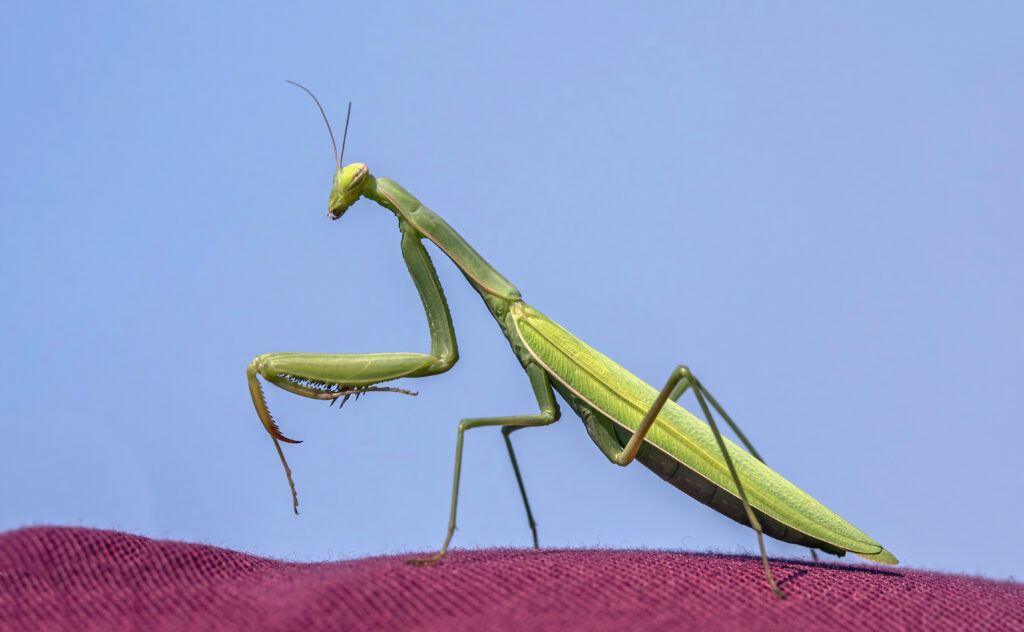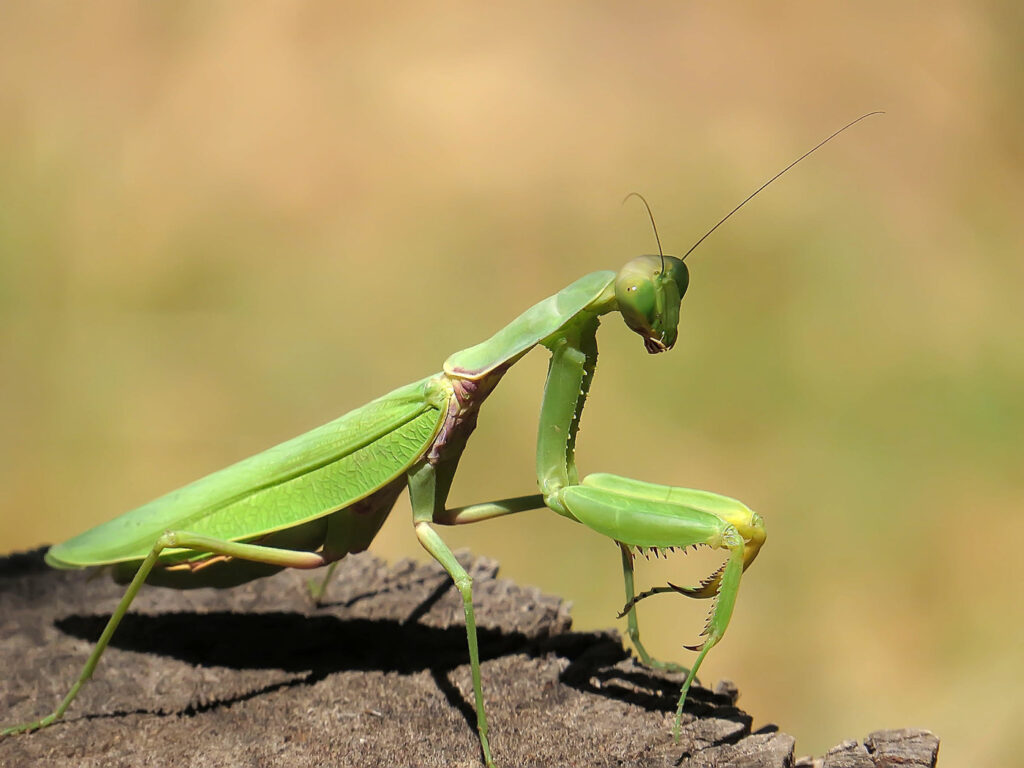Table of Contents
ToggleIntroduction
Praying Mantises, known for their distinctive appearance and intriguing behavior, are a captivating group of insects that have fascinated scientists, naturalists, and the general public for centuries. Their unique posture, with front legs held together as if in prayer, has earned them the name “praying mantis.”
These remarkable creatures belong to the order Mantodea, within the more extensive classification of arthropods. Despite their relatively small size, their presence significantly impacts various ecosystems. From their intricate hunting techniques to their role in biological control, the world of Praying Mantises offers a plethora of natural wonders to explore.
Taxonomy And Classification
Praying Mantises are members of the animal kingdom, classified under the phylum Arthropoda. Their specific order is Mantodea, and they belong to the family Mantidae. This family encompasses various species, each with its adaptations and characteristics. The Mantidae family includes well-known and lesser-known species, contributing to the biodiversity of these fascinating insects.
Anatomy And Physical Characteristics
Distinctive Body Structure and Morphology
Praying Mantises have a unique body structure that differentiates them from other insects. Their bodies have three main segments: the head, thorax, and abdomen. The most striking feature is their triangular head with a pair of large, compound eyes, providing them with exceptional vision. Their neck, also known as the “prothorax,” is elongated and flexible, enabling them to rotate their heads almost 180 degrees. This feature aids in locating and tracking prey.
Forelegs Adapted for Hunting and Capturing Prey
The forelegs of Praying Mantises are adapted for capturing prey with remarkable efficiency. These specialized legs are referred to as “raptorial legs.” They are armed with sharp spines and barbed structures that assist in securing and immobilizing their victims. The mantis’s hunting strategy involves patiently waiting in an ambush position until unsuspecting prey comes within striking distance. Their legs move swiftly to grasp the game, holding it tightly.
Camouflaged Coloration and Mimicry
Praying Mantises exhibit an array of colors and patterns that aid in camouflage. Some species resemble leaves, sticks, or flowers, allowing them to blend seamlessly into their surroundings. This camouflage helps them avoid predators and makes them highly effective ambush predators.
Life Cycle And Reproduction
Egg-Laying and Oothecae Formation
Female Praying Mantises lay eggs in structures called oothecae, which serve as protective capsules. These capsules are attached to surfaces such as branches or leaves, safeguarding the developing eggs from predators and environmental factors. The oothecae have different shapes and sizes based on the species.
Nymph Stages and Gradual Metamorphosis
Once the eggs hatch, young mantises, called nymphs, emerge. The nymphs undergo several molts, shedding their exoskeletons to accommodate their growing bodies. This process of gradual metamorphosis contrasts with the more abrupt transformations seen in other insect groups like butterflies.
Mating Rituals and Cannibalistic Behavior
Mating in Praying Mantises is a complex process. The male cautiously approaches the female, often engaging in elaborate displays to prove his worthiness.
However, the female has a reputation for occasionally exhibiting cannibalistic behavior, where she may consume the male after or even during copulation. This seemingly counterproductive behavior has evolutionary advantages, including increased nutrient intake and improved reproductive success for the female.
Hunting And Feeding Behavior

Ambush Predators and Patient Hunting Strategies
Praying Mantises are renowned for their hunting techniques involving patience, stealth, and precision. They assume an ambush position, relying on their camouflage to remain inconspicuous. When potential prey approaches, they strike with lightning speed, using their raptorial legs to capture and immobilize the victim.
Mimicry and Camouflage Tactics
Some Praying Mantises have evolved to mimic their surroundings. For instance, the Flower Mantis resembles a flower petal, attracting pollinators like bees and butterflies, which it subsequently preys upon. This mimicry demonstrates the complex adaptations that have evolved.
Feeding Preferences and Diet Diversity
Praying Mantises are voracious eaters with a diverse diet. They primarily feed on insects, including flies, moths, and crickets. However, larger species are known to prey on small vertebrates like lizards and even other mantises. Cannibalism is also common, especially among nymphs, where survival often involves consuming siblings.
Ecological Role And Ecosystem Impact
Natural Pest Control Benefits in Agriculture
One of the most valuable roles of Praying Mantises is their contribution to natural pest control in agriculture. Preying on agricultural pests, they help reduce the need for chemical pesticides, leading to more sustainable and environmentally friendly farming practices.
Prey-Predator Relationships and Impact on Insect Populations
Praying Mantises are integral to various ecosystems, participating in intricate prey-predator relationships. Their presence can regulate insect populations, preventing outbreaks of certain pest species and maintaining a balance within the ecosystem.
Contribution to Biodiversity and Food Chains
As predators, Praying Mantises occupy a crucial niche in the food chain. Their interactions with prey and predators influence the diversity and stability of ecosystems. They serve as a link between different trophic levels, affecting the abundance of various species within their habitats.
Cultural Significance And Symbolism
Mythology and Folklore Surrounding Praying Mantises
Throughout history, Praying Mantises have captured the human imagination, often appearing in myths, stories, and cultural beliefs. In some cultures, they are seen as symbols of luck, while in others, they are associated with spirituality and meditation.
Spiritual and Symbolic Significance in Various Cultures
The unique posture of the Praying Mantis has led to various symbolic interpretations. Its appearance of reverence and contemplation has linked it to meditation, mindfulness, and spiritual reflection in different cultural contexts.
Artistic Representations and Influence on Visual Aesthetics
The aesthetic appeal of Praying Mantises has inspired artists and designers across various mediums. Their graceful and intriguing appearance has been featured in art, fashion, and even architecture, underscoring their influence on human creativity.
Conservation And Threats

Habitat Destruction and Urbanization
Like many other species, Praying Mantises face habitat destruction and urbanization threats. As natural habitats are transformed into urban landscapes, the mantises’ ability to find suitable habitats and prey can be compromised.
Pesticide Use and Unintended Effects on Mantis Populations
While Praying Mantises provides natural pest control benefits, the indiscriminate use of pesticides can harm their populations. Pesticides target pests and impact beneficial insects like mantises, disrupting their role in maintaining ecosystem balance.
Importance of Maintaining Balanced Ecosystems
The conservation of Praying Mantises is crucial for maintaining healthy ecosystems. Their interactions with other species and their role in controlling pest populations emphasize the importance of preserving biodiversity and supporting sustainable practices.
Research And Scientific Discoveries
Studying Mantis Behavior and Adaptations
Scientists have conducted extensive research to uncover Praying Mantises’ intricate behaviors and adaptations. Understanding their hunting strategies, camouflage techniques, and reproductive behaviors provides insights into broader evolutionary and ecological principles.
Insights into Neurobiology and Vision Research
Praying Mantises’ exceptional vision has led to studies in the field of neurobiology and vision research. Their ability to track fast-moving prey and respond to visual cues has contributed to our understanding of insect visual processing.
Inspiration for Robotics and Biomimicry
The remarkable characteristics of Praying Mantises have inspired innovations in robotics and biomimicry. Researchers have drawn inspiration from their hunting techniques and vision systems to develop agile robots and enhance artificial intelligence algorithms.
Conclusion
Praying Mantis’s intriguing appearance, remarkable hunting techniques, and vital ecological roles continue to be subjects of fascination and admiration. From their symbolic significance in various cultures to their contributions to pest control and scientific research, these insects exemplify the diverse and captivating wonders of the natural world. As we strive to appreciate and conserve their unique qualities, we also acknowledge the importance of Praying Mantis maintaining balanced ecosystems and fostering a harmonious coexistence with the natural world.







